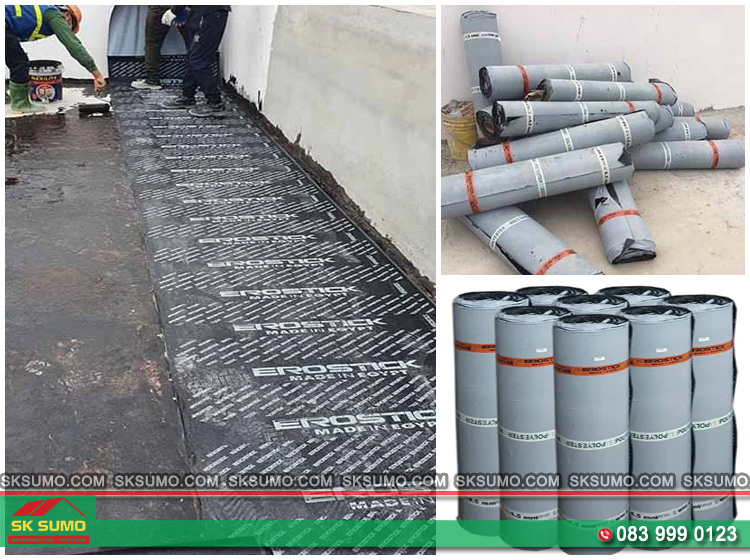Roll 50-100m, thick 1.5mm

In key waterproofing components of houses such as basements, foundations, rooftops, and landscape features, HDPE liner material is widely used thanks to its excellent water-blocking ability and long lifespan. Understanding the nature of the HDPE GPS 1.5mm waterproofing membrane is essential for choosing the right material for residential technical requirements.
The HDPE GPS 1.5mm waterproofing membrane is a high-density polyethylene (HDPE) sheet manufactured according to geomembrane standards, designed to create a stable water-barrier layer in buried environments. Its 1.5mm thickness delivers a balanced combination of mechanical strength, flexibility, and ease of installation, performing well under harsh conditions in housing projects. With a closed and stable polymer structure, the 1.5mm HDPE membrane provides near-absolute waterproofing, while also resisting chemicals, UV radiation, and compressive load.
In residential environments, this material functions as an independent water-barrier layer that does not rely on moisture conditions or substrate surfaces. This helps reduce the risks of reverse seepage, wall-base moisture, or structural damage in areas frequently exposed to water.
The technical factors of the HDPE GPS 1.5mm waterproofing membrane determine its durability in soil, water, and sunlight. Understanding the specifications helps investors and engineers accurately assess its suitability for residential construction.
The HDPE GPS 1.5mm waterproofing membrane is composed of:
Virgin HDPE provides tensile strength and resistance to cracking, while UV additives allow the material to withstand long-term sunlight exposure on rooftops or landscape ponds.
At 1.5mm thickness, the membrane offers:
This is why the 1.5mm type has become the standard for many high-end residential projects.
Key applicable standards include:
The 1.5mm GM13-grade version is especially suitable for basements, where high stability is required.
When choosing waterproofing materials, users often assume that there is only “one type of 1.5mm HDPE membrane.” In reality, even with the same thickness, HDPE GPS 1.5mm membranes come in several forms to suit different applications. Classification by surface type and technical standards helps ensure proper usage for basements, roof decks, or landscape features.
The HDPE GPS 1.5mm membrane for residential construction comes in two main surface types:
1. Smooth-surface HDPE GPS 1.5mm membrane
2. Textured-surface HDPE GPS 1.5mm membrane
In most residential projects, the smooth 1.5mm type is preferred due to its easier corner handling, weldability, and compatibility with flat surfaces.
Although both are HDPE GPS 1.5mm membranes, quality varies depending on manufacturing standards. In housing projects, the following standards evaluate durability, stability, and long-term waterproofing performance:
1. GM13-grade HDPE GPS 1.5mm membrane
2. GM17-grade HDPE GPS 1.5mm membrane
3. HDPE GPS 1.5mm membrane meeting ASTM + GM13
Understanding material characteristics helps homeowners and contractors evaluate whether the HDPE GPS 1.5mm waterproofing membrane is truly suitable for each component of the project.
These are significant advantages over PVC sheets or brush-applied waterproofing materials.
|
Material |
Advantages |
Disadvantages |
Suitable for housing |
|---|---|---|---|
|
HDPE 1.5mm |
Durable, fully waterproof |
Less flexible in tight corners |
Basements, foundations, roof decks |
|
Bitumen |
Strong adhesion |
Ages quickly |
Walls, balconies |
|
PVC |
Flexible, easy to install |
Poor UV resistance |
Small ponds |
|
EPDM |
Highly flexible |
High cost |
Landscape features, flexible ponds |

With excellent waterproofing, high durability, and low sensitivity to soil conditions, the HDPE GPS 1.5mm waterproofing membrane is increasingly used in townhouses, villas, garden homes, and residential projects.
The 1.5mm HDPE membrane is used as a protective liner for:
It prevents groundwater and moisture from penetrating concrete, reducing cracking and reverse seepage that may damage structure and interiors.
Rooftop areas used for planting or recreation are prone to water penetration. The HDPE GPS membrane provides comprehensive protection:
Landscape fish ponds, mini waterfalls, and garden water features require materials that are:
The 1.5mm HDPE membrane meets all these criteria.
Several misconceptions lead to improper usage or ineffective installation. Clarifying these helps ensure the correct use of the HDPE GPS 1.5mm waterproofing membrane.
HDPE is only suitable for wide, flat surfaces.
Not for:
Many projects choose 2.0mm thinking “thicker is better,” leading to:
In housing, 1.5mm is the standard.
Placing tiles directly on the membrane will cause punctures due to point loads.
Proper HDPE installation requires:
The HDPE GPS 1.5mm waterproofing membrane is an effective and stable solution for foundations, basements, roof decks, and landscape ponds. With high durability, excellent waterproofing, and long service life, it helps minimize water seepage risks in residential projects. Understanding its technical characteristics and ensuring correct installation maximizes its effectiveness. Homeowners and engineers should consider combining GM13-grade material with proper protective layers to enhance structural durability.
Yes. It always requires geotextile underneath and a protective layer above to prevent damage from impact or point loads.
No. HDPE is unsuitable for rough surfaces and small details such as bathrooms or balconies.
GPS is more durable, fully waterproof, and UV-resistant. PVC is softer but has lower lifespan, while EPDM is highly flexible but significantly more expensive.
Yes. HDPE is chemically stable and does not release toxins, making it safe for ornamental fish ponds and garden water features.
Yes, provided it is properly installed, protected, and made to GM13 standards.